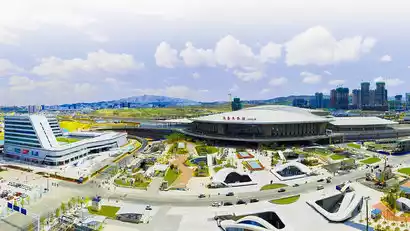Day 1 Various locations - Urumqi (★Activity gathering day)
All day
Today is the gathering day for the event. All tourists will proceed to the meeting hotel in Urumqi, the capital of Xinjiang Autonomous Region. Simply provide "China-Travel Note + Name" to check in.
Located in the heart of Asia, Urumqi is a world-renowned city of song and dance, a land of melons and fruits, and a land of gold and jade. If you have more time, you can plan your own activities in Urumqi city. For those interested in learning about Xinjiang's culture and history, the Xinjiang Museum (free, closed on Mondays) is highly recommended. For those seeking an exotic experience, the Erdaoqiao International Grand Bazaar showcases unique Western culture and a dazzling array of goods, promising great bargains.
When in Urumqi, don't miss the delicious Xinjiang cuisine: the nationally renowned Dapanji (Big Plate Chicken), crispy grilled lamb chops, grilled lamb skewers, Yili horse intestines, and various specialty noodles. In autumn, sunset typically occurs at 9:00 PM, and Urumqi remains bustling even at night. Explore the Grand Bazaar Night Market for a bite to eat.


Day 2 Urumqi → Turpan Karez → Flaming Mountain (Bezeklik Thousand Buddha Caves) → Kumtag Desert → Shanshan
·morning
After breakfast, we left. Tourists from all over the country laughed and talked along the way, introduced themselves to each other, and started a pleasant journey.
Our first stop is Turpan, known as the "Fire Continent," boasting one of the highest average temperatures in China. We'll visit the Jiaoheyi Karez Source, where snow from the Tianshan Mountains, dozens of kilometers away, flows through the Karez wells and becomes clear springs. This spring nourishes Turpan's Uighur people and irrigates tens of thousands of acres of vineyards, a testament to human ingenuity.
Afterward, we'll head to the famous Flaming Mountain, featured in "Journey to the West." China-TravelNote will eschew the commercialized Qianshan scenic area and delve into the heart of the Flaming Mountain Grand Canyon. Join a professional guide to explore the Bezeklik Thousand Buddha Caves, once a center of Western Buddhism and renowned for its exquisite murals and unique artistic style.
·afternoon
First, head to the hotel for a rest. Once the temperature drops in the afternoon, head to the Kumtag Desert. Located south of Shanshan County, this desert is part of the Taklamakan Desert. Its primary element is sand dunes, not sand dunes. The golden desert is majestic and magnificent, and for thousands of years, the sand has remained constant, while the green has remained undiminished.
We took the scenic shuttle bus into the desert, where we climbed barefoot sand dunes, experienced sandboarding, camel riding, and even took a ride on a desert surfer (note: all activities within the scenic area are at your own expense, so please be careful). The desert's curves are truly beautiful. We watched the sunset over the desert with friends, and reluctantly left. In the evening, we explored local specialties together.


Day 3 Shanshan → Hami Dahaidao (Sea Turtle, Two-Headed Horse, Eskaixiaer Castle Group) → Hotel in No Man's Land
All day
After breakfast, depart for the Dahaidao (Great Sea Road). Named after the vast sea of sand, the Dahaidao, also known as the Sand Sea Road, boasts a rich tapestry of ancient castles, beacon towers, post stations, prehistoric settlements, fossil mountains, mirages, herds of wild desert camels, and numerous other rare landforms. The Dahaidao runs southeast, stretching from Dikaner Village in Turpan, Xinjiang, in the west to Yumen Pass in Gansu, covering a distance of 456 kilometers. At its ends, it connects two important historical and cultural centers along the Silk Road: Turpan and Dunhuang.
Hami Dahaidao is the most essential part of Dahaidao, with the largest group of yardang landforms in the world.
Transfer to a four-wheel drive hard-core off-road vehicle (4 passengers per vehicle), enter from the main gate of the scenic area, pass by the vast sea turtle, the two-headed horse, the Aiskaixiaer castle group... Walk and play along the way, and feel the desolation of the Northwest and the magical Gobi scenery.
·night
Tonight, we'll stay at a newly opened hotel in the desert. In this vast expanse of desert, we'll watch the sun set, savor delicious food, and enjoy a wonderful desert day!
The starry sky is bright at night. You can hike to the star-chasing platform, leave the light source, and wait for the Milky Way to slowly rise.


Day 4: Hami Dahaidao → Core Area Safari (Pterosaur Canyon, Fairy Cave, Yadan Murals) → Desperate Great Wall (Eye of Lop Nur) → Hami
·morning
In the early morning, the sun slowly rises over the Gobi Desert, and the colors of the Devil City change ever-changing. Early risers can enjoy and photograph the sunrise over Dahaidao, while lazy people can continue to sleep in.
After breakfast, start today's [No Man's Land Safari] exploration trip. There is almost no life on the Gobi Desert. Every step you take may be the first step of mankind. Only by going deep into it can you feel the desolation and beauty.
The first stop is the Pterosaur Grand Canyon, where a large number of Hami pterosaur fossils have been unearthed. Wind erosion has made the top of the cliff uneven and undulating like a relief.
Our second stop is Shenxian Cave (also known as Tongtian Cave), the most striking spot in the Dahaidao Scenic Area. Millions of years of wind erosion and vortexing have shaped nested "U"-shaped etchings on the vertical cross-section of the Yadan rock mass. A narrow crack has appeared in the cave ceiling, allowing sunlight to pour in.
The third stop is the [Yardang Mural], a continuous mural wall more than 5 meters long. The erosion of flowing water and the carving of wind and sand have created this unique water erosion and wind erosion composite landform. It not only maintains the typical characteristics of the Yardang landform, but also exhibits rare graphic art.
·afternoon
Head to the heart of Dahaidao, the Great Wall of Despair. This little-known spot in the southwest of the Dahaidao Scenic Area features a 2-kilometer-long, wall-like group of yardangs, resembling the bones of a dragon. This naturally formed barrier, like a Great Wall constructed by the earth itself, derives its name from this.
If you have a drone, you can also take aerial photos and see the magical Eye of Lop Nur. You can also pick up small pieces of "agate" stone nearby. If you are interested, you can take some as souvenirs.
We will leave at the right time and stay in Hami, the gateway to eastern Xinjiang, tonight. In the evening, we will have some free time to explore the local cuisine.


Day 5 Hami → East Tianshan → Yiwu Populus euphratica Forest → Yiwu
All day
After breakfast, we will set out across the Eastern Tianshan Mountains to the border town of Yiwu County, which is the border between Xinjiang and Mongolia.
Explore the Yiwu Poplar Forest, where poplar trees, desert, and wasteland blend harmoniously with the blue sky and white clouds, echoing the beautiful Tuomurti Snow Mountain in the distance. Take a scenic bus deep into the forest, discovering the most beautiful trees along the way, or stroll along the train tracks and take photos amidst the golden trees.
After having fun, go to the hotel to rest.


Day 6 Yiwu → Jiangbulake → Qitai
All day
After breakfast, we will depart for Jiangbulake, a forest grassland at the northern foot of Tianshan Mountain.
Jiangbulake means "holy spring" or "spring of life" in Kazakh. Spectacular golden wheat fields, the mysterious slopes of the Tianshan Mountains, and the beautiful Jiangbulake forest-steppe are all within sight. Amidst the endless mountain ranges, golden wheat fields dotted with a few ancient trees, snow-capped peaks, mountains, forests, grasslands, cattle, sheep, and yurts... The area maintains its pristine natural ecology and unique alpine grassland scenery.
Kind tips:
Jiangbulake wheat fields are harvested in early September every year. After harvesting, wheat stubble is left, which has a strong sense of lines and is still very beautiful.


Day 7: Tianqitai → Beiting Protectorate Ruins → Tianchi Lake in Tianshan Mountains → Urumqi
·morning
After breakfast, we'll depart for a visit to the Beiting Protectorate Ruins Museum. Beiting Ancient City was built over 150 years during the Tang Dynasty's rule over the Western Regions through institutions such as Tingzhou and Beiting Protectorate. As an ancient city site at the northern foot of the Tianshan Mountains and a crucial stop on the northern route of the ancient Silk Road, Beiting Ancient City bears witness to the effective governance of Xinjiang by the Tang Dynasty from the Tang to the Song and Yuan dynasties, particularly during the Tang Dynasty, and the prosperity of the Silk Road.
·afternoon
Visit Tianchi Lake, known as the "Pearl of the Tianshan Mountains," and learn the legendary legend of the Queen Mother of the West hosting King Mu of Zhou on its shores. Tianchi Lake has been renowned throughout history. See the eight scenic spots of Tianchi Lake: the Dinghai Shenzhen, the South Mountain View of Snow, and the West Mountain View of Pines. Take in the stunning natural scenery: the crystal-clear waters are as translucent as gemstones, while the shores are lined with verdant pines and cypresses.
After having fun, return to Urumqi hotel to rest.


Day 8 Urumqi (★All day, disbandment day)
All day
On the day of disbanding, the tourists reluctantly left the beautiful Xinjiang and returned to their respective warm homes according to their flight or train schedules.









